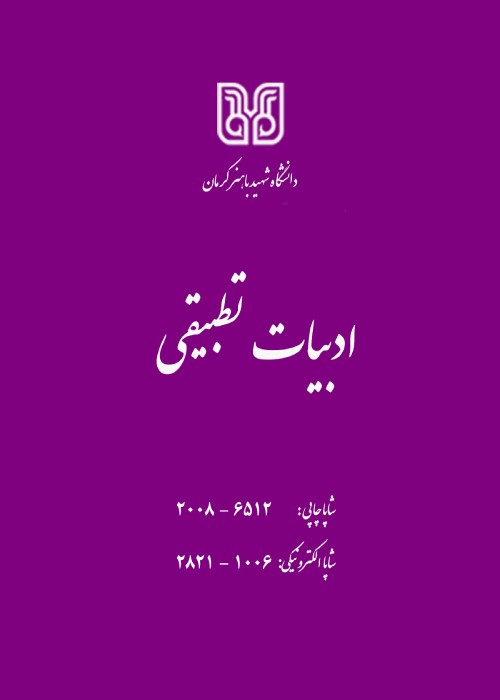Rhythm and Rhyme Management in Poetry Translation
The rhythm, which means the repetition of elements, is one of the principles in all arts: music, dance, poetry, and theatre. In poetry, the repetition of words, sounds, and phrases creates rhythm. Perhaps an example can clarify the concept of rhythm. If a person's footprint on the beach's sand is an example of rhythm, the places where he puts his foot on the sand and digs it is called a beat (or motif); And the distance between beats is called space. That is, we can consider rhythm a set of beats that are separated by spaces. Based on the differences between the beats of a chain or the differences between the spaces of a chain, we can classify the rhythms. In this article, we show that although rhythm is important, experts have not paid much attention to it. At first, we try to provide a more accurate definition of it; and we introduce its subcategories with the definition and example. Then we remind that in fact, the rhythm of poetry is one of the examples of rhythm; As well as one of the physical characteristics of the language.language can be divided into two semantic and physical layers from one perspective. The semantic layer consists of meanings and concepts. This layer is not an objective layer and its elements cannot be touched, seen, or heard. The physical layer consists of elements such as words or rhythms and rhymes. This layer is objective and tangible. In fact, in linguistic communication, the physical layer is transmitted and activates the semantic layer in the mind of the audience.
In the present study, we intend to achieve the most effective style of translation of poetry from French into Persian. For this reason, we have compared the opinions of various experts on the role of the physical layer of language in the translation of poetry; in addition, we have compared different styles of translation of poetry into Persian; we have also compared the types of rhythms and rhymes in Farsi.
In our opinion, the physical layer of language is highly used in literature, especially in poetry. Our issue is whether translators can translate the physical layer. Do we need to translate this layer? If the answer is yes, how should we do this? This paper attempts to answer these questions. Of course, our focus is on the rhythm and the rhyme, and we examine the «translation into Persian», not the «translation from Persian».We want to answer this question, which in the translation of poetry from European languages into Persian, considering the differences between them and Persian, a translator, what physical facilities can use. We know that rhythm and rhyme are a poem's most important physical elements, and we want to know what they do in the translation process. Our effort is to explain to the reader using a set of evidence, some of the ambiguous concepts.Based on the relationship that may form between the source poetry and the destination poetry, we can expect a variety of approaches to translating poetry. However, if we want to make a general classification, we can separate the three main approaches (Vide: Boase-Beier,2009: 194):Prose rendering. In this approach, semantic characteristics are recreated, and poetic characteristics such as rhythm and rhyme are eliminated. Such an approach can only convey the concepts and imagery to the translation audience.Adaptation. In this approach, the most important semantic characteristics and sometimes even the most important poetic characteristics are eliminated, to increase the impact of the poem created in the destination language. Translators who use this approach sometimes claim that the work they created must be evaluated as independent work.Recreative. In this approach, the semantic and poetic characteristics of the original poem are recreated using the destination language facilities. The purpose of the translation that chooses this approach is to achieve a relative resemblance between the poetry of origin and its translation.In this article, our focus is on the recreative approach. It should be noted that the methods of taking any approach could be changed. That is, in different ways, one can follow a specific path. Based on the relationship that may form between the origin rhythm and the destination rhythm, we can expect a variety of approaches. Overall, three approaches can be used to translate poetry rhythm (Vide: Holmes, 1988: 25-27):Mimetic. In this approach, the origin rhythm structure is recreated in the destination language; Of course, there is no guarantee for the result. Hexameters, for example, are natural for French speakers, while for English speakers who are accustomed to Pentameters, such a rhythm is heavy.Analogical. In this approach, a structure is used in the destination language, which has a similar effect to the origin rhythm structure. For example, in translation from France to English, pentameters are used instead of Hexameters.Organic. In this approach, the translator uses a rhythm that he thinks is more appropriate. That is, there is no relationship between the destination rhythm and the origin rhythm.We believe that the nature of the rhythm of poetry is not well known. Therefore, our first attempt is to study it. We have hypotheses that show how it works. The basics of the rhythm of poetry are different in different languages; we refer to them. Meanwhile, we explain different opinions and try to choose among them, the idea that seems more appropriate. We will talk about all kinds of rhythms and rhymes; and of course, in Persian poetry, rhyme and fixed-rhyme [: radif] are interrelated. When we talk about rhythm and rhyme, we also have to talk about modern formats and rhythms. We try to ignore semantic issues; in no way, we will not enter issues like imagination; we only deal with language physics. Then we introduce a kind of developed rhyme called super-rhyme, and we give examples to show its performance. Super-rhyme is objectively like a classical rhyme-in-prose [: saj?]. In the end, we examine three translations of a French poem.
Finally, we conclude that because the formats of classical Persian poetry and the vocabulary and concepts that form it are limited and unchanged, this genre cannot be a suitable container for the content of a poem from another culture. On the other hand, since the new vocabulary does not fit in the classic rhythm, the freshness of the source poem will be hurt. Therefore, to achieve the best result, it is better to use non-metric rhythm and super-rhyme; Classic formats generally restrict translation; so if they need to be used, we can simulate them; That is, we can create a quasi-classic format with non-metric rhythm and super-rhyme. In other words, non-metric rhythm and super-rhyme can greatly increase the quality of a translation. Every translated poem has two identities. An identity that is dependent on the source poem, and by comparing the translation with it, we can evaluate that identity, and an identity that is independent of the source poetry, and by comparing the translation with the poems in the target language, we can evaluate that identity; so a successful translation is a translation that has two acceptable identities. In the article, we have introduced a new style in translation, which consists of a kind of rhythmic prose and a kind of developed rhyme and maximizes the impact of a translated poem without weakening its semantic aspect.
- حق عضویت دریافتی صرف حمایت از نشریات عضو و نگهداری، تکمیل و توسعه مگیران میشود.
- پرداخت حق اشتراک و دانلود مقالات اجازه بازنشر آن در سایر رسانههای چاپی و دیجیتال را به کاربر نمیدهد.



